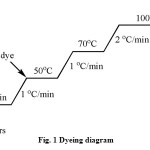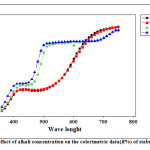Improvement of Dyeability Property and Color Fastness of Stabraq (Milkweed) Fibers Modified With Alkaline Treatment
Amir Hossein Monzavi, Laleh Maleknia* and Behnaz Behnoodi
Department of Textile Engineering, Islamic Azad University, South Tehran Branch, Tehran, Iran. Corresponding Author Email: melika02@azad.ac.ir
DOI : http://dx.doi.org/10.13005/ojc/31.Special-Issue1.12
Article Received on :
Article Accepted on :
Article Published : 09 Sep 2015
In this work, raw fibers of a local species of stabraq (milkweed) were scoured and bleached with alkaline treatment. The improved stabraq fibers were subjected to dyeing with two types of disperse dyes at 1% owf in a liquor ratio of 30:1, in the exhaustion dyeing method. The effects of various factors which may affect the dyeability property and color fastness of the treated fabric, such as alkali and dye concentration, were studied. Furthermore, CIE L*, a*, b* value, washing, light and stain fastnesses of the treated fabrics were evaluated. The results suggested that the dyeability of modified stabraq fibers with two disperse dyes used, resembles that of other cellulosic fibers more closely.
KEYWORDS:Stabrq; Milkweed; Alkaline treatment; Dyeing; Fastness
Download this article as:| Copy the following to cite this article: Monzavi A. H, Maleknia L, Behnoodi B. Improvement of Dyeability Property and Color Fastness of Stabraq (Milkweed) Fibers Modified With Alkaline Treatment. Orient J Chem 2015;31(Special Issue1). |
| Copy the following to cite this URL: Monzavi A. H, Maleknia L, Behnoodi B. Improvement of Dyeability Property and Color Fastness of Stabraq (Milkweed) Fibers Modified With Alkaline Treatment. Orient J Chem 2015;31(Special Issue1). Available from: http://www.orientjchem.org/?p=10685 |
Introduction
The majority of natural fibers are lignocelluloses in nature, they are considered as low value industrial fibers. But the improvements in fiber and yarn production technologies through constant and serious research over the years and ecological considerations have created a renewed research interest on the lingo cellulosic fibers to explore their potentials in textile and allied fields. In this respect, many well-known fibers, such as: jute, ramie, sisal, hemp, coir and etc., have been studied and well documented [1]. One of the least investigated lingo-cellulosic fiber is the seed fiber obtained from stabraq (milkweed). Milkweed is a valuable plant that is easy to grow in dry and arid climates, requires minimum water, and can be harvested for floss twice every year [2]. The parts of the milkweed plants are used for various applications. Fibers (floss) produced from the plant have low density (0.9 g/cm3) unlike any other natural cellulose fiber and attempts have been made to use the floss as a filling material in jackets and for nonwovens. However, the short lengths and low elongation limit the use of floss as a natural cellulose fiber for textile and other applications [3]. Its native Persian name is stabraq. It is a soft-wooded, ever green, perennial shrub [1]. In the available literature, though there have been some works on characterization of physical properties and spinning of these fibers, but there was no attempt to dye them. In view of the above situation, an attempt was undertaken to carry out a research to evaluate the dyeability of these fibers [4]. In this study, the effects of alkaline treatment on dyeing property and color fastness (light, stain and washing fastness) of stabraq fibers dyed with two disperse dyes were investigated.
Experimental
Materials
Materials and chemicals used in the study were: raw stabraq (milkweed) fiber, sodium hydroxide pellet (analytical grade, Merck, purity > 99.5%) for scouring and bleaching, sodium carbonate (analytical, Merck), distilled water and detergent, for washing the scoured fiber to remove the last traces of alkali existed in it. The disperse dyes, Papilion Yellow F-10GT 400% and Papilion Green F-FB, was kindly provided by L.A. SUPPLY Co.Ltd and used as received without further purification.
Instruments
All dyeing were carried out in sealed stainless steel dye pots of 300 cm3 capacity, dyeing machine using a liquor ratio of 30:1. The reflectance values and the corresponding CIE L*, a*, b* for the dyed samples were measured by using computer color matching (Gretag Macbath Color-Eye 7000A, USA) interfaced to a digital PC under illuminant D65, with a 100 standard observer.
Alkali Treatment of Jute Fabrics
Alkali treatment of stabraq fiber is one of the usual methods to produce high quality fibers. By removing the natural and artificial impurities, alkali treatment leads to fibrillation of the fiber bundle into smaller fibers. For this aim, stabraq fiber was dipped in 2 % NaOH solution for 1 h at room temperature. The fabrics were further washed with distilled water including a few drops of acetic acid. Then the jute fabrics were washed with fresh distilled water again until NaOH was removed. This procedure went on until washing water showed no longer any alkalinity. Next, the fabrics were oven-dried at 60°C[5].
Dyeing
All dyeing were carried out by using fibers which had been wetted out in cold tap water, employing a 30:1 liquor ratio and 1% owf. The dyeing procedures used for the two dyes are depicted in Figure 1. Finally, the dyed samples were rinsed thoroughly with cold and hot water and then were dried in air.
 |
Figure 1: Dyeing diagram Click here to View figure |
Colour Depth Measurements
The color strength of the dyed samples was determined from the sample reflectance (R). The reflectance (R) of the dyed samples was measured on a color measurement system, at the wavelength of minimum reflectance, under CIE Illuminant D65 and d/8° illumination/observation. In addition to visual assessments, the samples were also evaluated objectively by measuring the CIE LAB values (L*, a* and b*) of the dyed samples using above system, and then calculating the color change, ΔE. Illuminant D65 and 10° observer geometry were used throughout for the color measurement. [6].
Light , Stain and Washing Fastness
Dyed samples were tested according to ISO standard methods for fastness measurements; ISO 105 C03 (1989) for evaluating color fastness to washing, ISO 105 B02 (1989) for color fastness to light ing.
Results and Discussion
The main purpose of this investigation was to compare the dyeability properties of modified stabraq (milkweed) and raw fibers. We, therefore, attempt dyeing these fibers with two types of fluorescent disperse dyes, namely Papilion Yellow F-10GT 400% and Papilion Green F-FB. Because of the rigid structure and the low concentration of accessible sites in stabraq fibers, the lower diffusion and reaction for bulky dyes expected to occur. The relative open structure of the treated fibers, eases the diffusion of the dye into amorphous region of stabraq fibers and finally, more accessibility of sites, yields more fixations.
Table 1: The colorimetric data in modified stabraq (milkweed) and raw fibers
|
Sample’s name |
L* |
a* |
b* |
C* |
h° |
|
STB1 |
70.163 |
19.143 |
17.374 |
25.852 |
42.228 |
|
STB2 |
69.809 |
17.776 |
16.103 |
23.981 |
42.182 |
|
STB3 |
84.823 |
-8.774 |
31.299 |
32.506 |
105.659 |
|
STB4 |
85.304 |
-9.0256 |
30.215 |
31.534 |
106.631 |
The single cells in the milkweed stem fibers are much smaller in length and narrower than those in milkweed floss and in cotton and linen, but similar to the single cells in most other lignocellulosic agricultural byproducts [3]. The untreated stems have a layer of surface deposits mostly composed of lignin, hemicellulose, and other noncellulosic substances that cover the cellulose inside.
 |
Figure 2: The effect of alkali concentration on the colorimetric data(R%) of stabraq fibers dyed Click here to View figure |
The alkaline treatment removes most of the surface substances resulting in fibers with relatively clean and even surface. The milkweed stem fibers or single cells do not have the typical convolutions seen in cotton and some fibers obtained from agricultural byproducts [3]. In the case of lightness (L*) and chroma (C*), although the values for fibers dyed with Papilion Green F-FB is a little higher than those dyed with Papilion Yellow F-10GT 400%, it appears that L* and C* values are almost independent of the fiber type and mostly are dependent to the dyes used. Other colorimetric parameters such as: a*, b* and h° obtained, are in proper agreement with the expected hue characters of the applied dyes(Table 1).
Table 2: The results of wash stain and light fastness
|
Sample’s name |
L* |
a* |
b* |
C* |
h° |
|
STB1 |
70.163 |
19.143 |
17.374 |
25.852 |
42.228 |
|
STB2 |
69.809 |
17.776 |
16.103 |
23.981 |
42.182 |
|
STB3 |
84.823 |
-8.774 |
31.299 |
32.506 |
105.659 |
|
STB4 |
85.304 |
-9.0256 |
30.215 |
31.534 |
106.631 |
a Wash fastness 1 = Poor, 2 = Moderate, 3 = Fairly good, 4 = good, 5 = Very good
b Stain fastness 1 = very poor, 2 = poor, 3 = moderate, 4 = fairly good, 5 = good, 6 = very good 7 = Excellent, 8 = Outstanding
c Light fastness 1 = Poor, 2 = Moderate, 3 = Fairly good, 4 = good, 5 = Very good
Conclusions
A comparative study on the dyeability of stabraq fibers has been proceded; using Papilion Yellow F-10GT 400% and Papilion Green F-FB disperse dyes. The present investigation on the seed fiber of stabraq (milkweed) has revealed that the raw milkweed fibers and modified fibers become dyeable after chemical treatments. The color strength of treated milkweed fibers is higher than those of pure fibers. Overall, the obtained results, suggest that the dyeability of stabraq fibers with the two types of disperse dyes used, resembles that of other cellulosic fibers more closely. Also, washing, lighting and rubbing fastness of treated samples by various concentrations of dye was good, whereas their color fastness to washing was excellent.
References
- Bahreini Z, Kiumarsi A, Prog. Color Colorants Coat. 2008, 1, 19-26.
- Nourbakhsh A, Ashori A, and Kouhpayehzadeh M, Composites, J. Reinforced Plast. Comp, 2009, 28(17). 2143-2149.
- Reddy N and Yang Y, Polymer Engineering and Science 2009, 49(11), 2212–2217.
- G. L. Louis, B. Kottes, A. Tex. Res. Journal. 1987, 57, 339-345.
- Bozaci E., Sever K., Demir A., Seki Y., Sarikanat M., Ozdogan E., Fibers and Polymers, 2009; 10(6),781-786.
- Lee, Y,H., Dyeing, Journal of Applied Polymer Science, 2007, 103, 251–257.

This work is licensed under a Creative Commons Attribution 4.0 International License.









